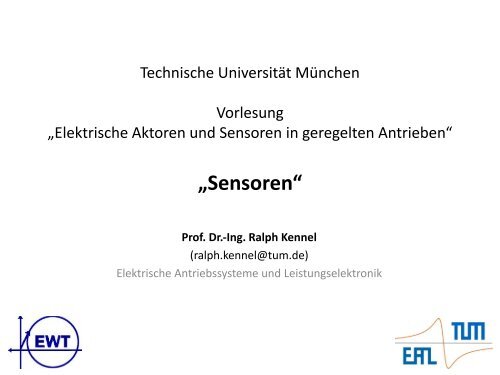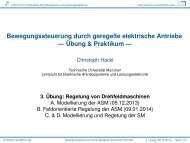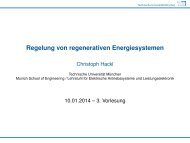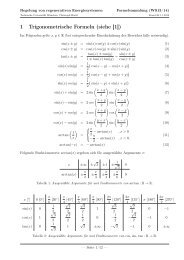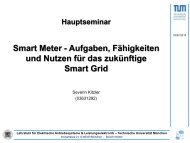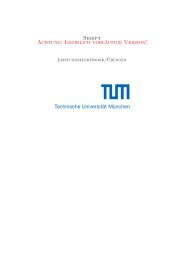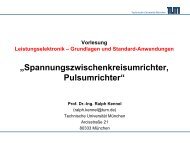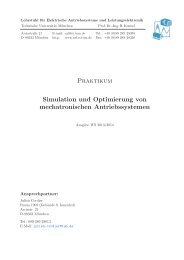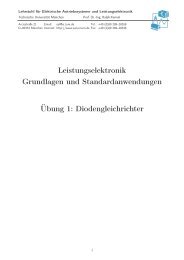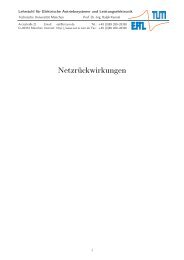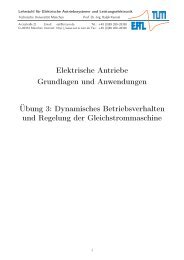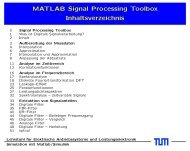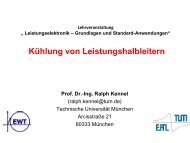Sensoren - Lehrstuhls für Elektrische Antriebssysteme und ...
Sensoren - Lehrstuhls für Elektrische Antriebssysteme und ...
Sensoren - Lehrstuhls für Elektrische Antriebssysteme und ...
You also want an ePaper? Increase the reach of your titles
YUMPU automatically turns print PDFs into web optimized ePapers that Google loves.
Technische Universität München<br />
Vorlesung<br />
„<strong>Elektrische</strong> Aktoren <strong>und</strong> <strong>Sensoren</strong> in geregelten Antrieben“<br />
„<strong>Sensoren</strong>“<br />
Prof. Dr.‐Ing. Ralph Kennel<br />
(ralph.kennel@tum.de)<br />
<strong>Elektrische</strong> <strong>Antriebssysteme</strong> <strong>und</strong> Leistungselektronik
Technische Universität München<br />
Vorlesung<br />
„<strong>Elektrische</strong> Aktoren <strong>und</strong> <strong>Sensoren</strong> in geregelten Antrieben“<br />
„<strong>Sensoren</strong>“<br />
Temperatursensoren
Pt100<br />
• Pt100-<strong>Sensoren</strong> sind Temperaturfühler,<br />
die auf der Widerstandsänderung von Platin<br />
unter Temperatureinfluss basieren.<br />
• Es handelt sich um Widerstandsthermometer, <strong>und</strong> zwar um Kaltleiter (PTC).<br />
• Pt100 (R 0= 100 Ohm)<br />
• Pt200 (R 0= 200 Ohm)<br />
• Pt500 (R 0= 500 Ohm)<br />
• Pt1000 (R 0= 1 kOhm)<br />
• die Widerstandsänderung ist in DIN EN 60751 (2009-05) festgelegt.<br />
• Standardisierung � leichte Austauschbarkeit der Temperaturfühler<br />
ohne Neukalibrierung<br />
• Pt100 genauer als Thermoelemente.
Bauformen des Pt100
European Standards -marking and Directives<br />
EU Directive<br />
• European Directive ‘safety of machines’<br />
• safe insulation<br />
• safe emergency stop<br />
• safe standstill without energy switch-off<br />
(e.g. double channel supervision)<br />
• safe limitation of motion<br />
� European Directive ‘low voltage’<br />
• safety against electrical shock<br />
� European Directive ‘EMC’<br />
• low harmonics in the mains<br />
• new product standard EN 61800-3 (IEC 1800-3)
mains<br />
EN 60204<br />
2000 V<br />
EN 61800-3<br />
1 300 V<br />
2 000 V ss<br />
ss<br />
VDE 0100<br />
400 V~<br />
VDE 0551<br />
3 750 v~<br />
overvoltage category I : VDE 0110<br />
Controller<br />
pulse voltage L --> L up = 750 V<br />
L --> PE up = 1500 V<br />
Isolation voltage L --> PE U = 800 V~<br />
test voltage L --> PE U = 640 V~<br />
Isolation Requirements<br />
VDE 0884<br />
xxx V~<br />
2 500 V~ 2 500 V~<br />
750 V=<br />
400 V~<br />
4 000 V ss<br />
DC link motor cable<br />
Capacitor<br />
VDE 0551<br />
3 750 v~<br />
Controller<br />
1 / 0 1 / 0<br />
overvoltage category II : VDE 0110<br />
pulse voltage L --> L up = 1200 V<br />
L --> PE up = 2500 V<br />
Isolation voltage L --> PE U = 1400 V~<br />
test voltage L --> PE U = 1200 V~<br />
VDE 0884<br />
xxx V~<br />
2 500 V~ 2 500 V~<br />
750 V=<br />
400 V~<br />
4 000 V ss<br />
2 500 V~<br />
temp.<br />
sensor<br />
overvoltage category III : VDE 0110<br />
pulse voltage L --> L up = 2000 V<br />
L --> PE up = 4000 V<br />
Isolation voltage L --> PE U = 2200 V~<br />
test voltage L --> PE U = 1800 V~
Technische Universität München<br />
Vorlesung<br />
„<strong>Elektrische</strong> Aktoren <strong>und</strong> <strong>Sensoren</strong> in geregelten Antrieben“<br />
„<strong>Sensoren</strong>“<br />
Stromsensoren
Ohne Feldsensor<br />
Strommessung Technik<br />
Shunt<br />
Rogowskispule<br />
Stromwandler<br />
magnetische<br />
Kopplung<br />
Strommessung<br />
Faraday-Effect<br />
Magnetwiderstand<br />
Hall-Effekt<br />
Magnetostriktion<br />
Technische Universität Warschau - Elektrotechnik<br />
mit Feldsensor<br />
8
Widerstand Strommessung<br />
Spannungsabfall<br />
Im<br />
• Spannungsabfall V auf dem bekannten Shunt R<br />
• der höhere Widerstand R, die höhere Spannung V<br />
Nachteile<br />
• Widerstand Anschluss in der Stromleiterbahn<br />
R<br />
• Keine Galvanische Trennung<br />
V<br />
Technische Universität Warschau - Elektrotechnik<br />
9
Current sensing with shunts (IR)<br />
low cost, low power solution with all drawbacks of shunts<br />
Quelle : Prof. Dr. -Ing. J. M. Pacas, Universität Siegen
Shunt measurement<br />
• precision resistors for current sensing should have:<br />
• a low temperature coefficient,<br />
• a low thermal EMF,<br />
• a high long-term stability,<br />
• a low inductance and<br />
• a high (pulse) load capacity.<br />
• these features are defined by selection of the resistance alloys,<br />
while properties are mainly determined by the construction.<br />
Quelle : Prof. Dr. -Ing. J. M. Pacas, Universität Siegen
Sensor Module (Isabellen Hütte)<br />
The ISA-ASIC, a combination of CMOS-ASIC and high precision shunt,<br />
basically is a low noise chopper stabilized 16 bit data acquisition system<br />
for extremely low input signals and therefore convenient for a lot of applications.<br />
Quelle : Prof. Dr. -Ing. J. M. Pacas, Universität Siegen
Hall-Effect<br />
• Halleffekt tritt im Leiter- oder in Halbleitermaterialien<br />
auf<br />
• Lineares Ausgangssignal<br />
• Unterschiedliche Empfindlichkeit <strong>und</strong> Bandbreite<br />
abhängig von Material<br />
• DC Stromkomponente kann gemessen werden<br />
• Stromquelle muss stabil sein<br />
Technische Universität Warschau - Elektrotechnik<br />
13
VH<br />
Hall-effect - Hallsensor<br />
B d<br />
IS<br />
Hall Platte<br />
Technische Universität Warschau - Elektrotechnik<br />
V � H<br />
I<br />
S<br />
B<br />
ned<br />
I s – Stromquelle <strong>für</strong> Hall-element<br />
d – Hall-element Dicke<br />
e – Elektronenladung<br />
n – Beweglicheladungen Dichte<br />
B – magnetische Induktion<br />
14
<strong>Sensoren</strong> ohne Rückkopplung<br />
• Unkompliziert<br />
• Fest<br />
(+)<br />
(-)<br />
• Niedrige Präzision (genügend <strong>für</strong><br />
bestimmte Systeme)<br />
• Nichtlinear<br />
• Temperaturempfindlich<br />
• Feldsensor muss weit<br />
Meßbereich haben<br />
Technische Universität Warschau - Elektrotechnik<br />
15
Z1<br />
I1<br />
Ф=-Ф0<br />
I2<br />
d0<br />
R<br />
I2<br />
Z2<br />
Ф<br />
VOUT<br />
<strong>Sensoren</strong> mit Rückkopplung<br />
Ф0<br />
Hallsensor<br />
I2<br />
Amp<br />
+Vc<br />
-Vc<br />
Ausgleichsspule<br />
Ф0<br />
Ф<br />
- Ausgleichs<br />
Magnetfluss<br />
- Magnetfluss<br />
von I1<br />
Technische Universität Warschau - Elektrotechnik<br />
(+)<br />
• Kompensation durch rückgekoppelten<br />
Strom<br />
• Sensor kann niedrig Meβbereiche<br />
haben<br />
• Temperaturkompensation<br />
• Strom- oder Spannungsausgangssignal<br />
• Bessere Linearität<br />
• höhere Präzision als <strong>Sensoren</strong> ohne<br />
Rückkopplung<br />
(-)<br />
• Probleme mit Ausgleich der hohen<br />
Ströme – hohe Induktivität der Spule<br />
• braucht bipolare Energieversorgung<br />
16
The MagnetoResistive (MR) Effect<br />
Magneto resistive sensor<br />
In thin films of permalloy (FE-Ni) material, the electrical<br />
resistance changes when an external magnetic field is applied in<br />
the plane of the film. The change is due to the rotation of the film<br />
magnetization. The variation of the resistance due an external<br />
field is called the anisotropic magnetoresistive (AMR) effect.<br />
Quelle : Prof. Dr. -Ing. J. M. Pacas, Universität Siegen<br />
Current Measurement<br />
The operating principle of by MRSensors<br />
current sensors is based on a differential<br />
field measurement with compensation.<br />
The primary current is fed through a<br />
conductor, creating a field gradient Hprim<br />
between the two sides of the conductor.<br />
The thin film magnetoresistive resistors<br />
are placed on a silicon chip and are<br />
connected in a Wheatstone bridge. The<br />
chip is mounted together with the<br />
analogue interface electronics on a single<br />
in-line hybrid circuit. In order to obtain a<br />
high linearity (0.1%) and a low<br />
temperature sensitivity, a current I S is fed<br />
back to the sensor chip through a<br />
compensation conductor located above<br />
the magnetoresistive resistors. The<br />
resulting field Hcomp exactly<br />
compensates Hprim, so that the sensor<br />
always works aro<strong>und</strong> a single point. At<br />
the output of the sensors, the<br />
compensation current flows.
different current measurements on drives<br />
Quelle : Prof. Dr. -Ing. J. M. Pacas, Universität Siegen
overcurrent conditions and their likely causes.<br />
Overcurrent Due to<br />
Line-to-line short<br />
Gro<strong>und</strong> fault<br />
Miswiring, motor leads<br />
short, phase-to-phase<br />
insulation breakdown<br />
Motor insulation<br />
breakdown to gro<strong>und</strong><br />
Shoot through Misfiring of IGBTs<br />
Quelle : Prof. Dr. -Ing. J. M. Pacas, Universität Siegen
Failure in one leg<br />
Quelle : Prof. Dr. -Ing. J. M. Pacas, Universität Siegen
Protection with one sensor<br />
Low cost solution but vector control and<br />
earth current protection are not possible!<br />
Quelle : Prof. Dr. -Ing. J. M. Pacas, Universität Siegen
Earth current<br />
Quelle : Prof. Dr. -Ing. J. M. Pacas, Universität Siegen
L1<br />
L2<br />
L3 L2<br />
Current measurement on DC-link<br />
Sensor for max<br />
current control<br />
Sensor for earth<br />
current protection<br />
earth current protection can be carried out<br />
with an additional sensor<br />
Quelle : Prof. Dr. -Ing. J. M. Pacas, Universität Siegen
�<br />
Rogowski Coil<br />
H� ds � w �i<br />
for a coil with … wird n turns inper<br />
length<br />
the flux linkage is determined by:<br />
Standard-Industrieantrieben<br />
d�nicht � � �eingesetzt A� n �H �ds<br />
0<br />
� � � �A �n �H �ds �<br />
� … also 0 wozu ???<br />
� � � A � n � w �i<br />
0<br />
�<br />
…wäre nützlich <strong>für</strong><br />
geberlose � �0 � A � n �Regelung � H �ds �<br />
von Asynchronmaschinen<br />
For the induced voltage results:<br />
� … spätere Präsentation<br />
d� di<br />
u � � �0 �A �n � w �<br />
dt dt<br />
Quelle : Prof. Dr. -Ing. J. M. Pacas, Universität Siegen
Technische Universität München<br />
Vorlesung<br />
„<strong>Elektrische</strong> Aktoren <strong>und</strong> <strong>Sensoren</strong> in geregelten Antrieben“<br />
„<strong>Sensoren</strong>“<br />
Drehzahl-/Positionssensoren<br />
… nächste Präsentation !!!
Fragen ?


